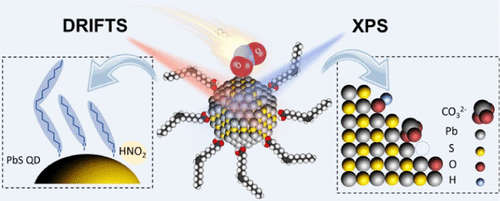当前位置:
X-MOL 学术
›
J. Phys. Chem. C
›
论文详情
Our official English website, www.x-mol.net, welcomes your feedback! (Note: you will need to create a separate account there.)
Operando Investigation of the Aging Mechanism of Lead Sulfide Colloidal Quantum Dots in an Oxidizing Background
The Journal of Physical Chemistry C ( IF 3.7 ) Pub Date : 2021-09-03 , DOI: 10.1021/acs.jpcc.1c04045 Tamara Russ 1, 2 , Zhixiang Hu 3 , Benjamin Junker 1, 2 , Huan Liu 3 , Udo Weimar 1, 2 , Nicolae Barsan 1, 2
The Journal of Physical Chemistry C ( IF 3.7 ) Pub Date : 2021-09-03 , DOI: 10.1021/acs.jpcc.1c04045 Tamara Russ 1, 2 , Zhixiang Hu 3 , Benjamin Junker 1, 2 , Huan Liu 3 , Udo Weimar 1, 2 , Nicolae Barsan 1, 2
Affiliation

|
Lead sulfide (PbS) is a p-type semiconductor that is often applied in photodetectors and solar cells. One major problem that researchers are regularly confronted with is the loss of performance when operated in air. The sensitivity to the ambient, however, makes it an interesting material for the application in gas sensors. Although a lot of research has been focused on the aging of PbS, the influencing factors and the associated material changes are still a matter of debate. Resistance measurements of differently prepared PbS samples operated as sensors for the detection of NO2 (a strongly oxidative gas) in combination with surface-sensitive methods (diffuse reflectance infrared Fourier transform spectroscopy and X-ray photoelectron spectroscopy) enabled the investigation of the changes associated with aging and their influence on the sensing mechanism. The aging mechanism was found to be predominantly influenced by the presence of residuals of the stabilizing agent oleic acid that was adsorbed at the surface of the colloidal quantum dots. Additionally, it was found that a byproduct of the consumption of oleic acid enhanced the detected sensor signal.
中文翻译:

氧化背景下硫化铅胶体量子点老化机制的操作研究
硫化铅 (PbS) 是一种 p 型半导体,常用于光电探测器和太阳能电池。研究人员经常面临的一个主要问题是在空气中操作时性能的损失。然而,对环境的敏感性使其成为气体传感器应用的有趣材料。尽管很多研究都集中在 PbS 的老化上,但其影响因素和相关的材料变化仍然存在争议。不同制备的 PbS 样品的电阻测量用作检测 NO 2 的传感器(强氧化性气体)与表面敏感方法(漫反射红外傅里叶变换光谱和 X 射线光电子能谱)相结合,能够研究与老化相关的变化及其对传感机制的影响。发现老化机制主要受吸附在胶体量子点表面的稳定剂油酸残留物的影响。此外,还发现油酸消耗的副产品增强了检测到的传感器信号。
更新日期:2021-09-16
中文翻译:

氧化背景下硫化铅胶体量子点老化机制的操作研究
硫化铅 (PbS) 是一种 p 型半导体,常用于光电探测器和太阳能电池。研究人员经常面临的一个主要问题是在空气中操作时性能的损失。然而,对环境的敏感性使其成为气体传感器应用的有趣材料。尽管很多研究都集中在 PbS 的老化上,但其影响因素和相关的材料变化仍然存在争议。不同制备的 PbS 样品的电阻测量用作检测 NO 2 的传感器(强氧化性气体)与表面敏感方法(漫反射红外傅里叶变换光谱和 X 射线光电子能谱)相结合,能够研究与老化相关的变化及其对传感机制的影响。发现老化机制主要受吸附在胶体量子点表面的稳定剂油酸残留物的影响。此外,还发现油酸消耗的副产品增强了检测到的传感器信号。



























 京公网安备 11010802027423号
京公网安备 11010802027423号